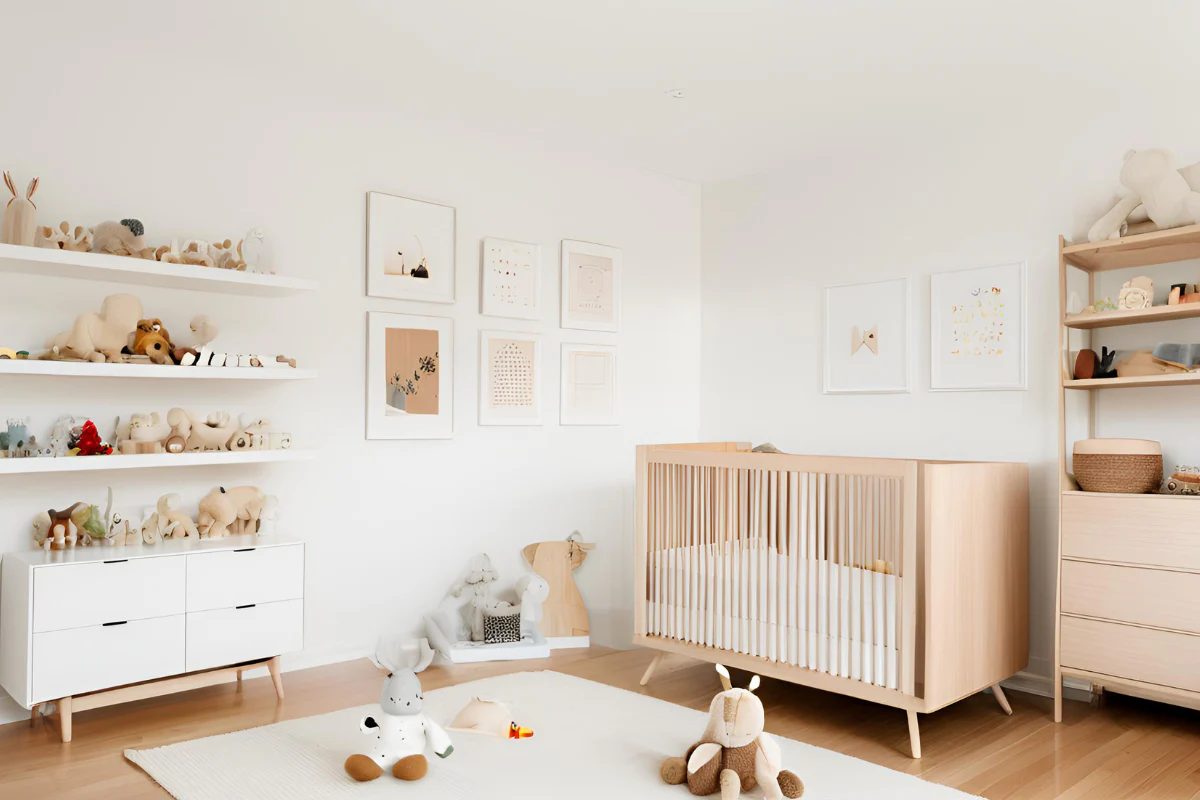The Scandinavian approach to nursery design has captivated parents worldwide with its perfect balance of functionality, simplicity, and warmth. This Nordic-inspired aesthetic creates serene spaces that foster calm and creativity—essential elements for your child’s early years.
The hallmarks of Scandinavian nurseries—neutral palettes, natural materials, and uncluttered spaces—align beautifully with modern parenting philosophies that value minimalism and sustainability.
Beyond mere aesthetics, Scandinavian nursery design embodies the concept of “hygge” (pronounced hoo-ga), the Danish art of creating intimate, cozy atmospheres that promote contentment and well-being.
This quintessential Nordic philosophy is particularly apposite for nurseries, where creating a sanctuary for both parent and child is paramount.
Scandinavian Nursery Ideas
The following 15 Scandinavian nursery ideas will guide you through transforming your baby’s room into a tranquil Nordic haven where simplicity meets sophistication.
1. Neutral Color Palette with Subtle Accents
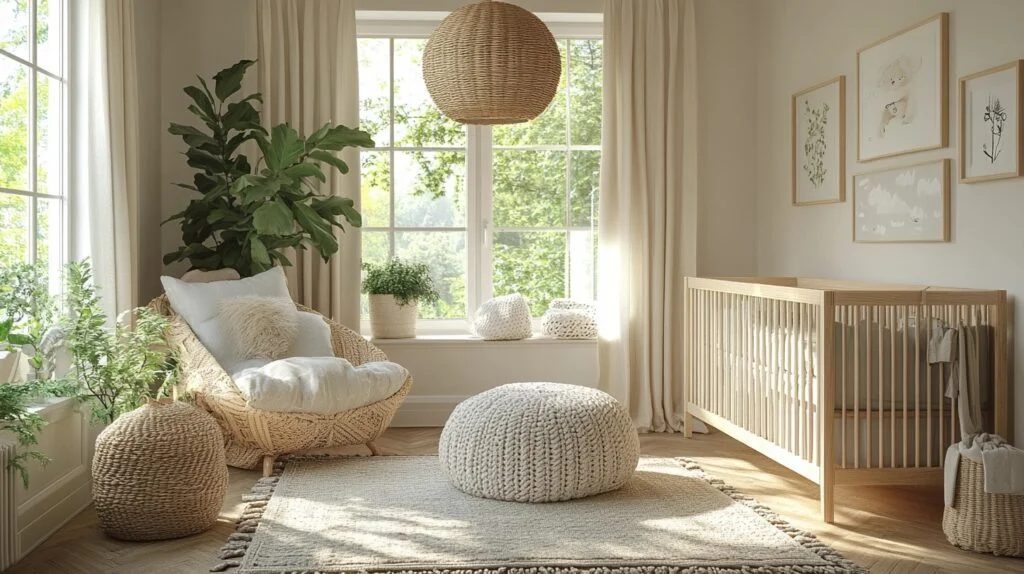
The foundation of any Scandinavian nursery begins with a neutral color palette. Whites, creams, soft grays, and pale woods create a bright, airy atmosphere that makes the space feel larger and more peaceful. This clean backdrop serves as the perfect canvas for your baby’s colorful toys and books without overwhelming their developing senses.
Add subtle pops of color through carefully selected accessories like cushions, rugs, or wall art to prevent the space from feeling too clinical. Consider muted pastels, dusty blues, gentle greens, or terracotta tones that complement rather than compete with the neutral foundation. The beauty of this approach is its adaptability—you can easily refresh the room as your child grows simply by switching out these accent pieces.
2. Natural Wood Elements
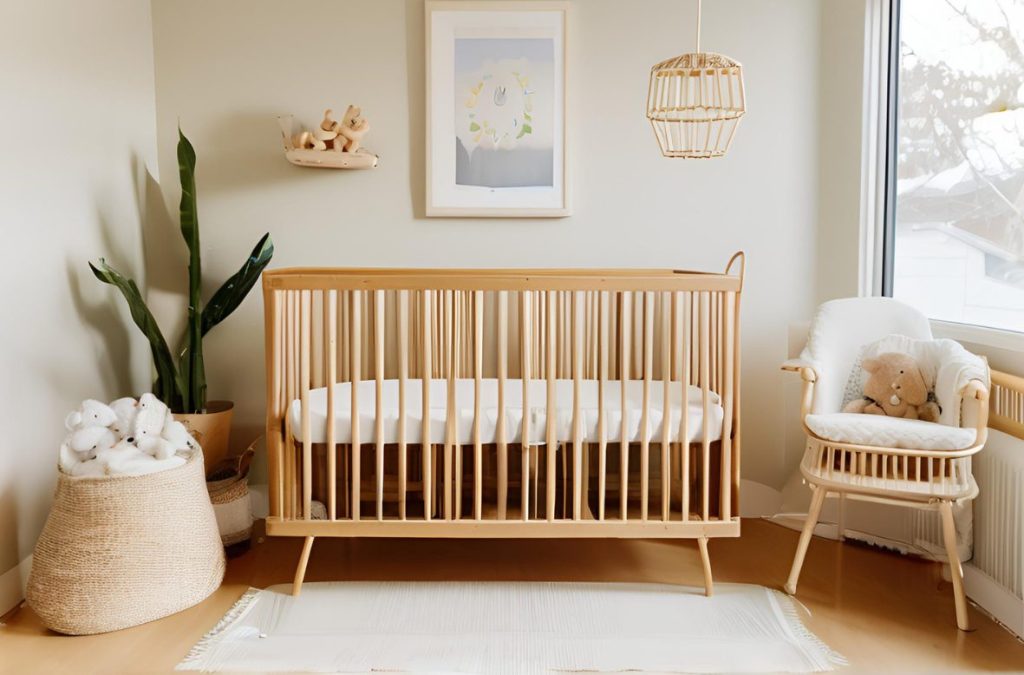
Incorporating natural wood is essential for authentic Scandinavian design. Opt for furniture pieces crafted from light, untreated woods like pine, birch, or maple that bring warmth and texture to the nursery while maintaining the bright, airy feel characteristic of Nordic interiors.
A wooden crib with clean lines becomes the centerpiece of the room, while wooden shelving, changing tables, or rocking chairs complete the look. For added charm, include smaller wooden elements like toys, picture frames, or wall hooks. The natural imperfections and grain patterns in the wood add visual interest and connect the space to nature—a core principle in Scandinavian design philosophy.
3. Minimalist Furniture with Clean Lines
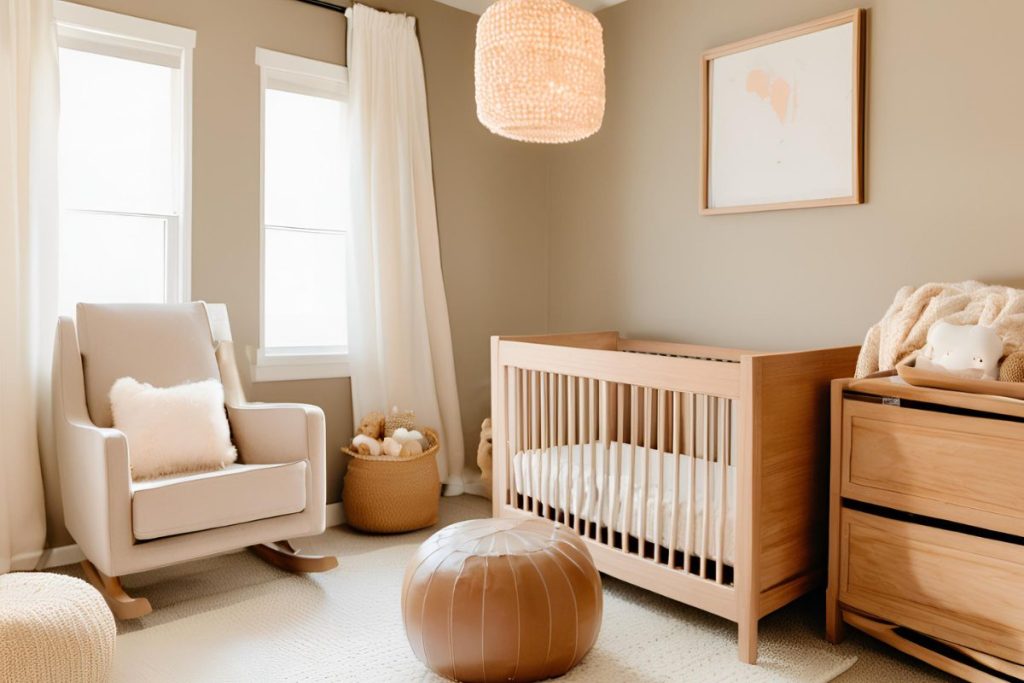
When selecting furniture for a Scandinavian nursery, embrace “less is more.” Choose pieces with clean, simple lines and multifunctional capabilities that exemplify Nordic design principles of practicality and minimalism. A convertible crib that transforms into a toddler bed offers longevity, while a changing table with built-in storage addresses immediate needs.
Avoid overcrowding the space with unnecessary furniture. Each piece should serve a purpose and contribute to the room’s functionality. This intentional approach to furnishing creates an uncluttered environment that’s easy to clean and navigate—particularly important during middle-of-the-night feedings. The spaciousness also provides ample floor area for your growing baby to explore and play.
4. Textural Layers
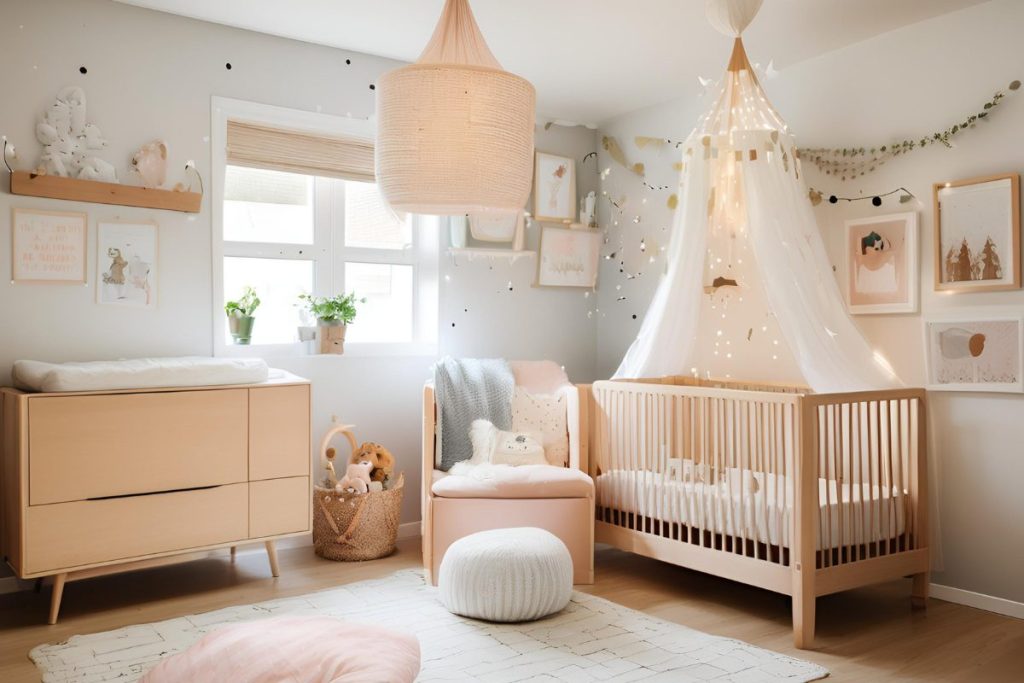
While Scandinavian design favors minimalism, it never feels sterile thanks to thoughtful layering of textures. Incorporate soft, tactile elements like sheepskin rugs, chunky knit blankets, or linen curtains to add dimension and coziness to the nursery, creating that characteristic hygge atmosphere.
Different textures also provide sensory stimulation for your baby’s development. Consider a variety of natural materials—from smooth cotton and rough jute to plush wool and sleek wood. Textile wall hangings or macramé decorations add visual texture and acoustic benefits by softening sound in the room. These textural elements transform a simple space into a nurturing environment that engages your baby’s developing senses.
Related Guide: 14 Eclectic Baby Nursery Ideas
5. Strategic Lighting Design
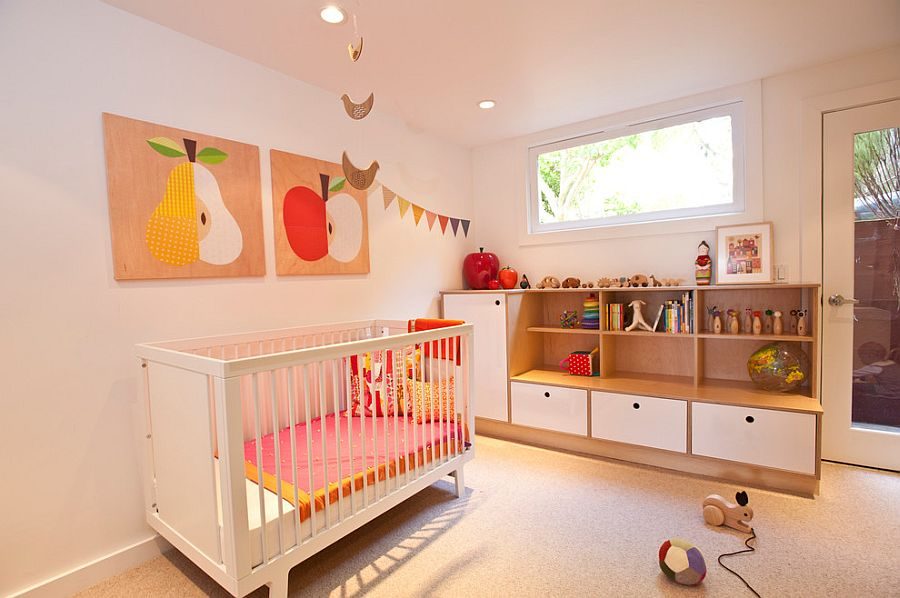
Lighting plays a crucial role in Scandinavian design, particularly in northern countries where daylight is precious. Maximize natural light with sheer window treatments that provide privacy without blocking illumination. For artificial lighting, create layers with a combination of overhead fixtures, table lamps, and night lights.
Install dimmer switches to adjust brightness according to different activities—brighter for playtime and diaper changes, softer for bedtime routines and nighttime feedings. Consider pendant lights with wooden or paper shades that cast a warm glow, or wall sconces that provide indirect lighting. A statement light fixture can also serve as an artistic focal point while still maintaining the clean aesthetic of Scandinavian design.
6. Geometric Patterns and Prints
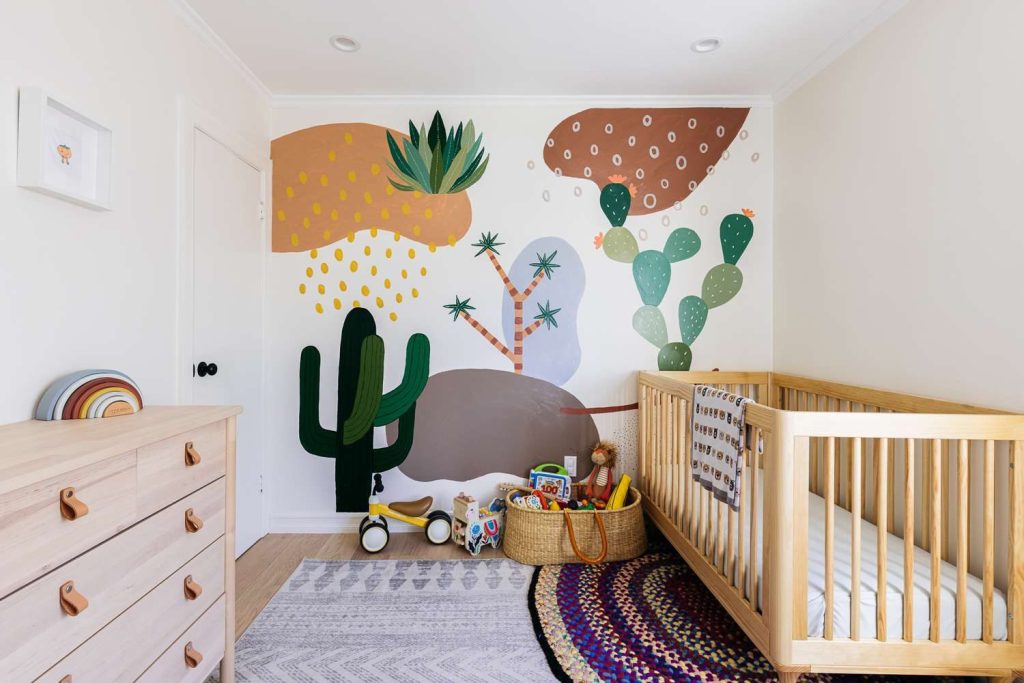
Scandinavian design often incorporates simple geometric patterns that add visual interest without overwhelming the space. Consider wallpaper with subtle triangles, mountains, or grid patterns on a feature wall, or introduce these elements through textiles like crib sheets, cushions, or area rugs.
Black and white geometric patterns are particularly effective in Scandinavian nurseries, as they create high-contrast visuals that stimulate infant visual development while maintaining the clean Nordic aesthetic. For a softer approach, opt for muted colors or metallic accents that catch the light. These geometric elements add a contemporary touch that balances the natural materials and keeps the nursery feeling fresh and modern.
7. Functional Wall Storage
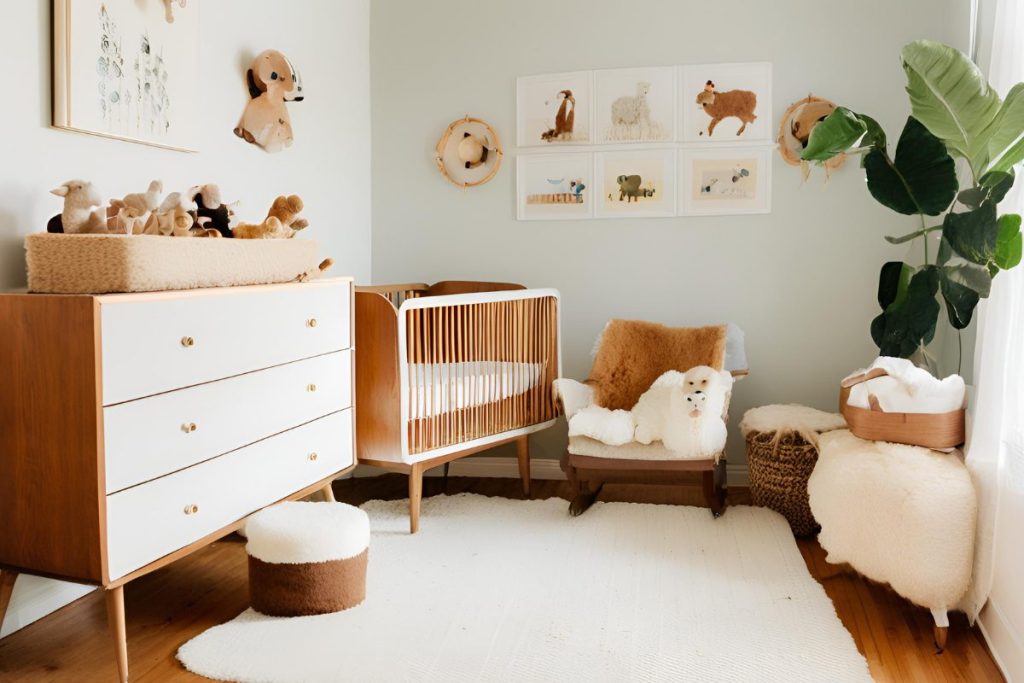
Vertical storage solutions are essential in Scandinavian nurseries, maximizing floor space while keeping necessities accessible. Install floating shelves to display books with covers facing forward, encouraging early interest in reading. Wall-mounted cabinets provide closed storage for items that might create visual clutter.
Pegboards offer flexible storage that adapts as your child grows—initially holding diaper caddy supplies and later accommodating artwork displays or educational materials. Wall pockets crafted from fabric or leather create charming storage for small items while contributing to the room’s aesthetic. These thoughtful storage solutions maintain the minimalist environment while ensuring everything has its place.
8. Monochrome with Nature-Inspired Elements
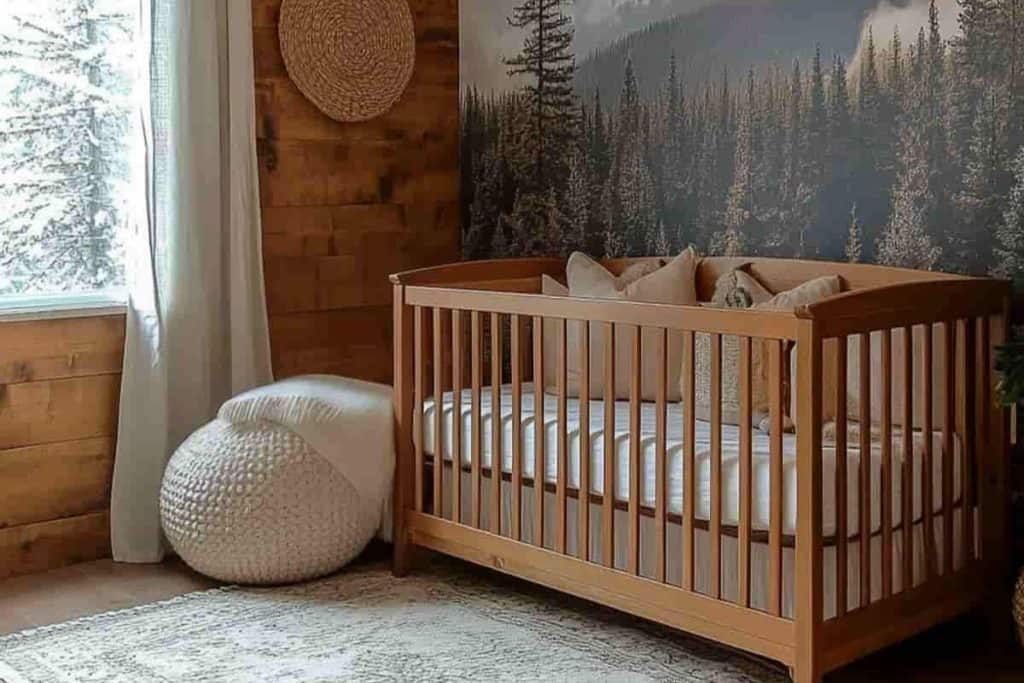
A black and white color scheme creates a sophisticated backdrop that supports infant visual development while adhering to Scandinavian design principles. This high-contrast palette stimulates babies’ developing eyesight and creates a timeless aesthetic that grows with your child.
Balance the monochrome base with nature-inspired elements like wooden toys, potted plants (placed safely out of reach), or botanical prints. These natural accents soften the stark contrast and bring warmth to the space. The juxtaposition of geometric black and white patterns with organic forms creates visual interest while maintaining the harmonious balance that characterizes Nordic design.
9. Statement Wall Treatments
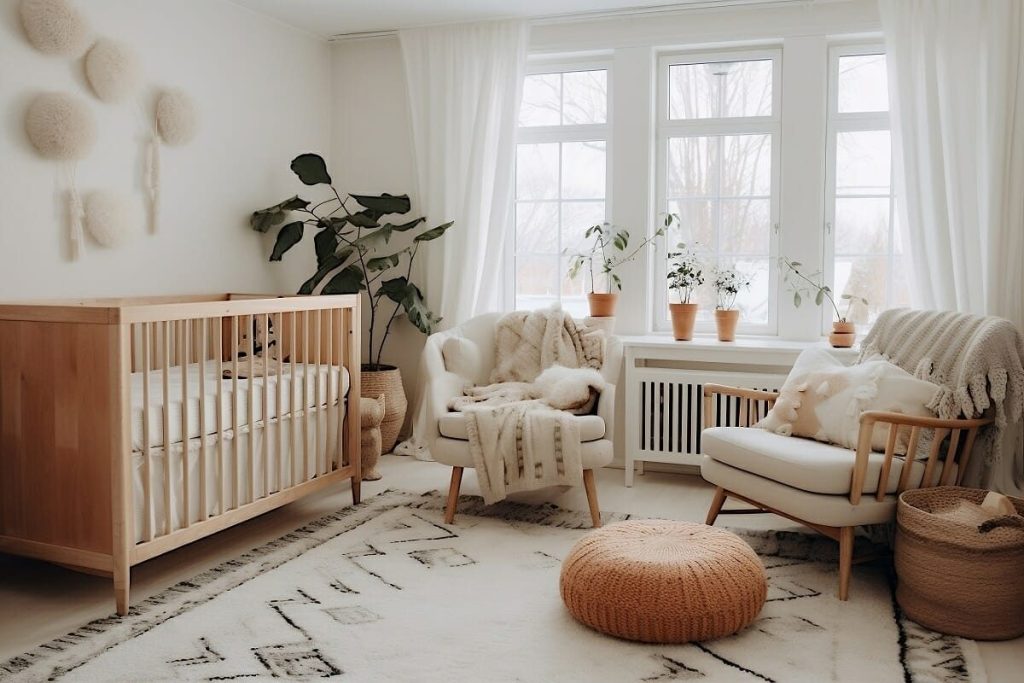
Create visual interest with a thoughtfully designed statement wall that anchors the nursery while preserving the overall simplicity. Consider delicate wallpaper featuring subtle patterns like dots, lines, or abstract shapes in muted tones. For a less permanent option, removable decals of mountains, trees, or stars introduce Nordic-inspired motifs without commitment.
Wood paneling or shiplap painted in white or soft gray adds texture and architectural interest while maintaining the light, airy feeling.
Another option is a simple painted feature wall in a complementary neutral tone. The statement wall provides a focal point that draws the eye without overwhelming the senses—making it perfect for the wall behind the crib where your baby will spend significant time.
10. Handcrafted and Sustainable Accessories
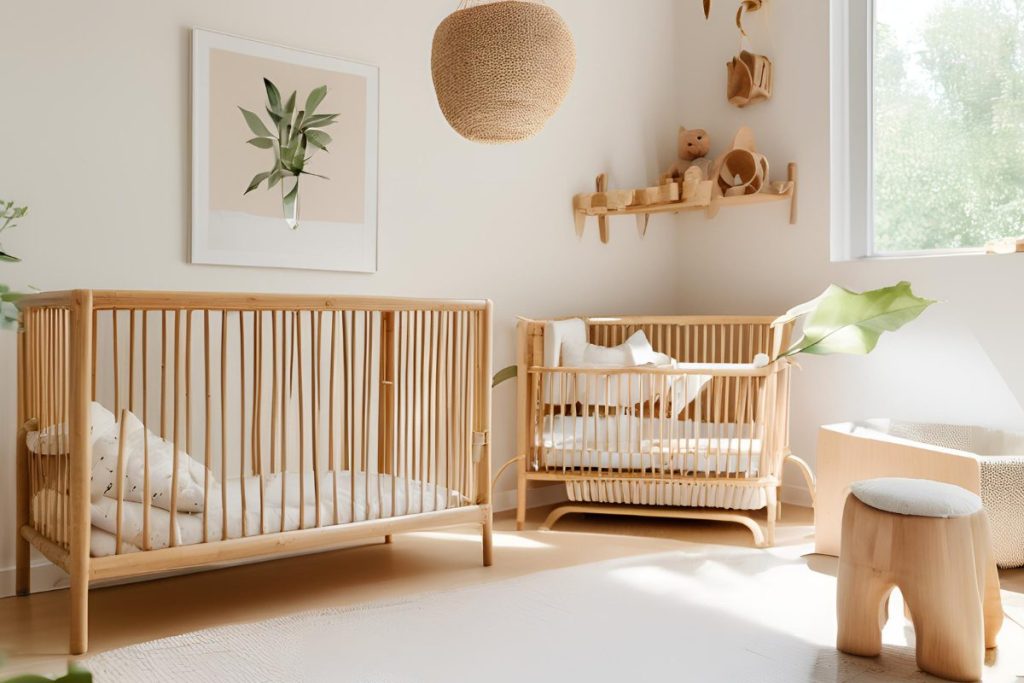
Scandinavian design celebrates craftsmanship and sustainability, values worth incorporating into your nursery through thoughtfully selected accessories. Choose handmade wooden toys, hand-knitted blankets, or artisanal mobiles that bring unique character to the space while supporting small makers and sustainable production methods.
These authentic pieces often become cherished heirlooms rather than disposable items, aligning with the Nordic emphasis on quality over quantity. Look for fair trade stuffed animals, organic cotton textiles, or repurposed vintage elements that tell a story. These mindful choices create a nursery filled with items that have meaning and purpose, teaching your child the value of craftsmanship and environmental consciousness from the earliest age.
Related Guide: 12 Innovative Jungle Nursery Ideas
11. Cozy Reading Nook
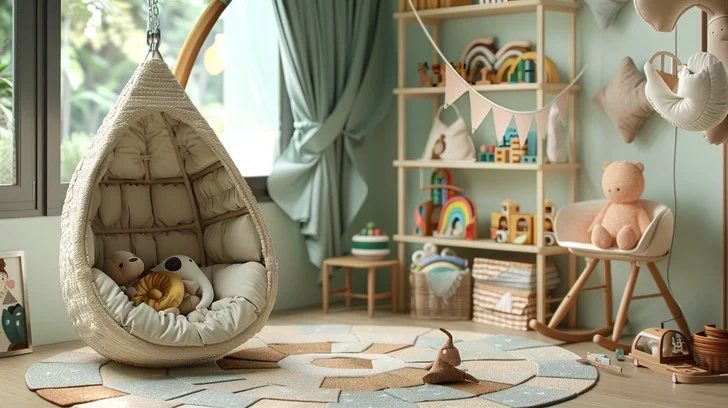
Creating a dedicated reading corner embodies the Scandinavian concept of hygge while encouraging early literacy. Position a comfortable chair—perhaps a minimalist rocker or a classic nursing chair with clean lines—near a window for natural reading light. Add a small side table for books and a soft floor cushion where your child can eventually sit independently.
Complete the nook with a textural throw blanket, a small bookshelf displaying favorite titles, and a gentle reading lamp for evening story times. This intentional space becomes the heart of your nursery routine, facilitating those precious bonding moments over books while creating a peaceful retreat for feeding and cuddling. As your child grows, this area evolves naturally into a spot where they can explore books independently.
12. Playful Nordic Animal Motifs
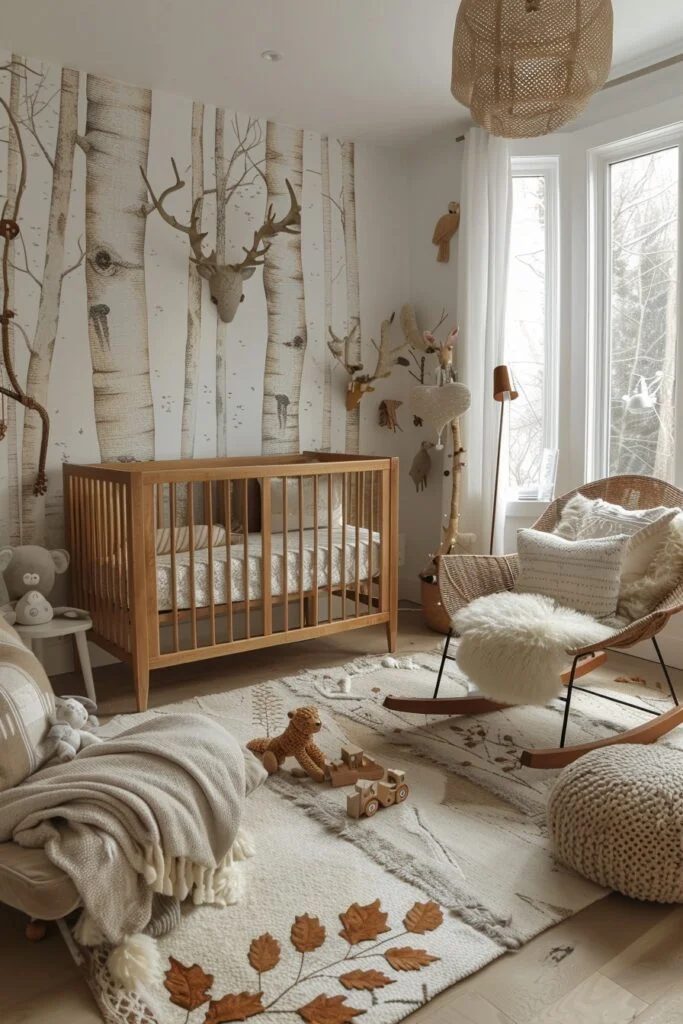
Incorporate whimsical animal motifs that reference Scandinavian wildlife for a playful touch that maintains the Nordic aesthetic. Foxes, bears, deer, rabbits, and woodland creatures feature prominently in Scandinavian children’s design, appearing in stylized, modern interpretations rather than cartoonish renderings.
These charming animals can be introduced through wall art, bedding, cushions, or decorative objects. Consider framed illustrations in simple black frames, stuffed animal toys in muted colors, or wooden animal figurines displayed on shelves.
These creatures bring personality and storytelling opportunities to the nursery while preserving the sophisticated simplicity that makes Scandinavian nurseries so appealing to both children and adults.
13. Indoor Plants for Natural Elements
Bringing nature indoors is a cornerstone of Scandinavian design, and carefully selected plants add life and improved air quality to your nursery. Choose child-safe varieties like spider plants, Boston ferns, or parlor palms that thrive indoors and place them in simple ceramic or wooden planters that complement the room’s aesthetic.
Position plants away from the crib but where they can be appreciated—perhaps on high shelves, wall-mounted planters, or atop dressers. For those concerned about plant maintenance or safety, high-quality artificial plants or botanical prints can provide similar visual benefits. This connection to nature supports the Scandinavian belief in the restorative power of natural elements, creating a healthier environment for your growing child.
14. Custom Wall Murals and Decals
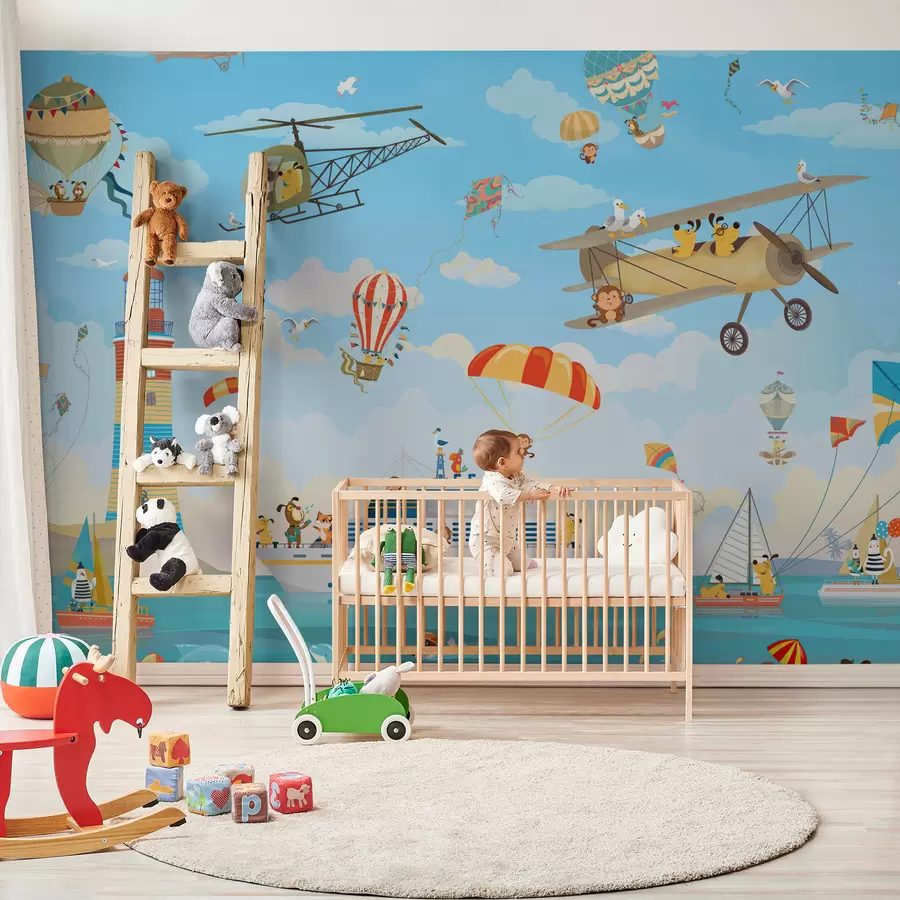
A subtle wall mural or carefully placed decals can add personality to a Scandinavian nursery without overwhelming the space. Choose designs with Nordic inspiration—mountains, forests, stars, or abstract landscapes in muted colors that complement your neutral palette.
These artistic elements can be positioned behind the crib or changing area, providing visual stimulation during diaper changes and quiet time. For maximum flexibility, opt for removable options that can be changed as your child grows.
Hand-painted murals using non-toxic paints create one-of-a-kind features, while quality decals offer an easier application with similar impact. These personalized touches make the nursery uniquely yours while maintaining the serene Scandinavian atmosphere.
15. Gender-Neutral Design Elements
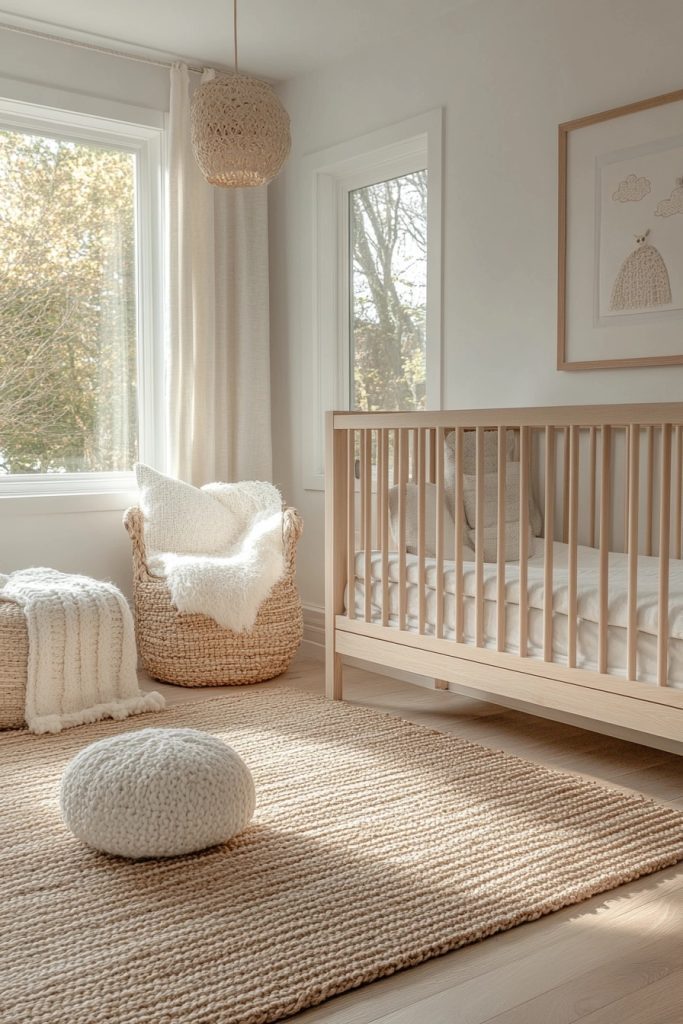
The inherently gender-neutral quality of Scandinavian design makes it perfect for modern nurseries, regardless of your child’s gender. Embrace this inclusive approach with a color palette focused on whites, grays, and natural wood tones rather than traditional pink or blue. Add interest through texture, pattern, and form instead of gender-specific themes.
This timeless approach creates a versatile space that adapts easily to changing preferences and potentially multiple children. Select furniture, textiles, and toys based on quality, functionality, and aesthetic appeal rather than gender marketing. The resulting nursery feels contemporary and welcoming, free from unnecessary gender constraints while honoring the egalitarian values at the heart of Scandinavian culture.
Conclusion
The enduring appeal of Scandinavian nursery design lies in its thoughtful balance of aesthetics and practicality. These 15 ideas demonstrate how Nordic principles create spaces that are not only visually beautiful but genuinely supportive of your child’s development and your experience as a parent.
The emphasis on natural materials, functional simplicity, and serene atmosphere fosters a nurturing environment where both baby and parents can thrive.
As you implement these Scandinavian-inspired elements, remember that authenticity comes from embracing the philosophy behind the aesthetic—creating a space that promotes well-being, connection to nature, and mindful living.
Your nursery becomes not just a room for your baby, but a sanctuary that embodies your family’s values and creates the foundation for your child’s earliest memories. Through this Nordic lens, you can craft a timeless nursery that grows with your child and provides a peaceful backdrop for those precious first years.

